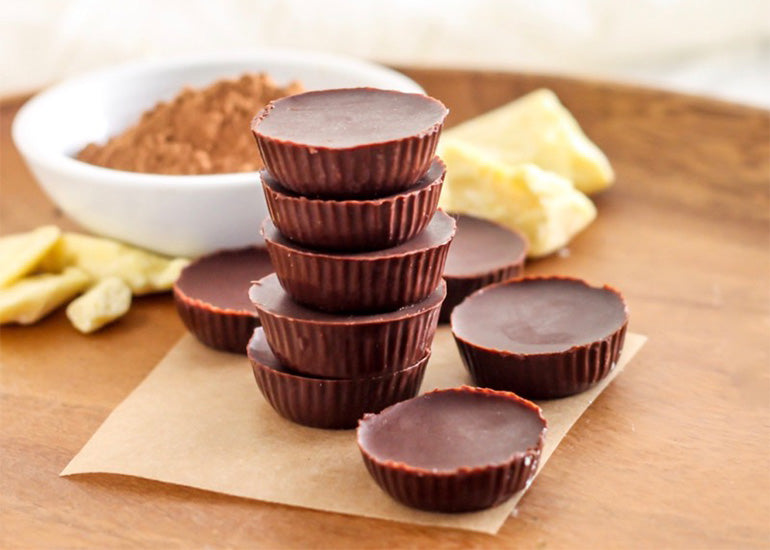1. What is tempered Cacao Butter?
If you do a lot of baking and cooking, you may have come across the phrase “tempered chocolate” before. So what exactly does it mean?
Cacao butter, the pure fat from the cacao bean, contains fatty acids with different physical qualities. In solid form, these fatty acids are bound together in crystalline formations (six distinctly different formations, to be precise!) but when the cacao butter is melted, these crystalline forms separate. Depending on the time and temperature at which the cacao butter is melted and then cooled, the fatty acids will harden into one or a variety of these formations. Tempered chocolate has been carefully handled so that the fats harden only into form V.
What’s so great about form V? Form V (tempered) chocolate is incomparable when it comes to cacao aesthetics. It’s responsible for the glossy exterior of dipped truffles, the snappy texture of chocolate bars, and the reason you can hold any of these candies in your hand without creating a gooey, melted mess.
Untempered chocolate, on the other hand, hardens with a matte sheen and sometimes an ashy-white film around the edges (if you’ve ever salvaged a candy bar from the dashboard of your car in the summer, you know exactly what I’m talking about!). It also has a lower melting point, softening at just around body temperature.
If you’re not into technical baking and I lost you back at crystalline form V, good news: tempering is optional. In fact, if you’re using cacao butter in baked goods like brownies, creamy lattes, or body care products, there’s no need for it at all. It’s only when you’re aiming to impress with glossy chocolate candies (like our Superfood Mendiants) or crisp chocolate coatings that you might consider tempering your cacao. And while it does have some fairly strict rules around temperature and process, it’s also quite simple, requiring nothing more than a kitchen thermometer, a decent stirring spoon, and a bit of patience. And happily, you can fail at tempering and still succeed at making perfectly delicious chocolate!
If you decide to give tempering a whirl, one thing to know is that the temperature rules vary slightly by type of chocolate; cacao butter and dark chocolate have the same temperature requirements, while white and milk chocolate differ, due to the varying amount of dairy fat. The following process can be used for dark chocolate and cacao butter:
- Slowly heat your cacao butter to 115F to melt all crystalline forms
- Let the cacao butter cool to 85F, stirring throughout (this is the temperature at which type V crystals form; stirring ensures that they do so)
- Carefully increase the temperature to 90F while continuing to stir (this will eliminate any lower temperature crystalline forms that may have occurred)
- And… you did it! Pour your candies, dip your truffles, or fill your molds.
Note: remember to let your chocolate harden at room temperature or in a cool basement instead of the fridge; the humidity inside a refrigerator can cause condensation to occur on the surface of your chocolate, ruining all of your hard tempering work!
2. Does your Cacao Butter contain heavy metals?
Good news here: no. While cacao is known to contain certain heavy metals from the soil, like lead and cadmium, almost none of these compounds are found in cacao butter.
In the processing of cacao, the bean is gently ground, heated, and pressed until the oils and solids separate, becoming cacao powder and cacao butter. Almost all of the solid compounds, including minerals, caffeine, and—yes—heavy metals, remain bound in the plant fibers that make up the bulk of unsweetened cacao powder.
So is cacao butter nutritionally worthless? Absolutely not! Cacao butter contains heart-healthy fats, like stearic and oleic acid, and two important fat-soluble vitamins, E and K. It also retains many of the valuable, anti-inflammatory flavonoids that cacao is prized for. Adding cacao butter to hot drinks and bowls can increase satiety, energy and nutrient absorption. Happy hot cocoa season!
Do you have a superfood question for Kali? Send it to her at askus@navitasorganics.com!
See what other burning superfood questions customers are asking in our candid "Your Questions Answered" Blog Series here.
)

